-
【语义分割】2021-Segmenter ICCV
【语义分割】2021-Segmenter ICCV
论文题目:Segmenter: Transformer for Semantic Segmentation
论文链接: https://arxiv.org/abs/2105.05633v3
论文代码: https://github.com/rstrudel/segmenter
论文翻译:https://blog.csdn.net/qq_42882457/article/details/124385073
发表时间:2021年5月
引用:Strudel R, Garcia R, Laptev I, et al. Segmenter: Transformer for semantic segmentation[C]//Proceedings of the IEEE/CVF International Conference on Computer Vision. 2021: 7262-7272.
引用数:182
1. 简介
1.1 摘要
图像分割在单个图像块的层次上通常是模糊的,需要上下文信息才能达成一致。本文介绍了一种用于语义切分的转换模型 Segmenter。
与基于卷积的方法相比,我们的方法允许在第一层和整个网络中对全局上下文进行建模。我们以最近的视觉转换器(ViT)为基础,将其扩展到语义分割。为此,我们依赖于与图像块对应的输出嵌入,并使用逐点线性解码器或掩码 Transformer 解码器从这些嵌入中获取类标签。
我们利用预先训练的图像分类模型,并表明我们可以在中等大小的数据集上对其进行微调,以进行语义分割。线性解码器已经可以获得很好的结果,但是通过生成类掩码的掩码转换器可以进一步提高性能。我们进行了广泛的消融研究,以显示不同参数的影响,尤其是对于大型模型和小面积贴片,性能更好。Segmenter在语义分割方面取得了很好的效果。它在 Ade20K 和 Pascal 上下文数据集上都优于最先进的技术,在城市景观数据集上具有竞争力
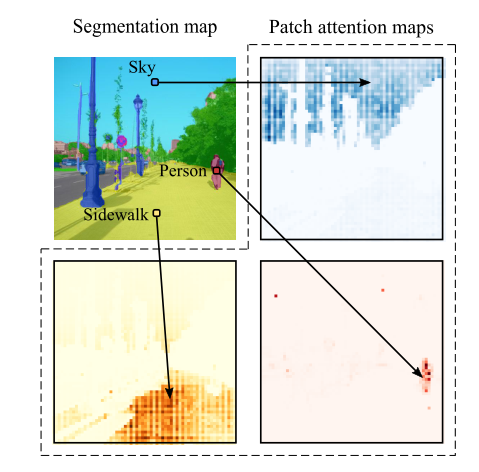
1.2 创新点
1)提出了一种基于 Vision Transformer 的语义分割的新颖方法,该方法不使用卷积,通过设计捕获上下文信息并优于基于 FCN 的方法;
2)提出了一系列具有不同分辨率级别的模型,允许在精度和运行时间之间进行权衡,从最先进的性能到模型具有快速推理和良好性能的模型;
3)提出了一种基于 Transformer 的解码器生成类掩码,其性能优于我们的线性结构,并且可以扩展以执行更一般的图像分割任务;
4)证明了此方法在 ADE20K 和 Pascal Context 数据集上产生了最先进的结果,并且在Cityscapes 上具有竞争力。
2. 网络
2.1 整体架构
Segmenter完全基于transformer的编解码器体系结构,利用了模型每一层的全局图像上下文。
- 基于ViT,将图像分割成块(patches),并将它们映射为一个线性嵌入序列;
- 用编码器进行编码;
- 再由Mask Transformer将编码器和类嵌入的输出进行解码,上采样后应用Argmax给每个像素一一分好类,输出最终的像素分割图。
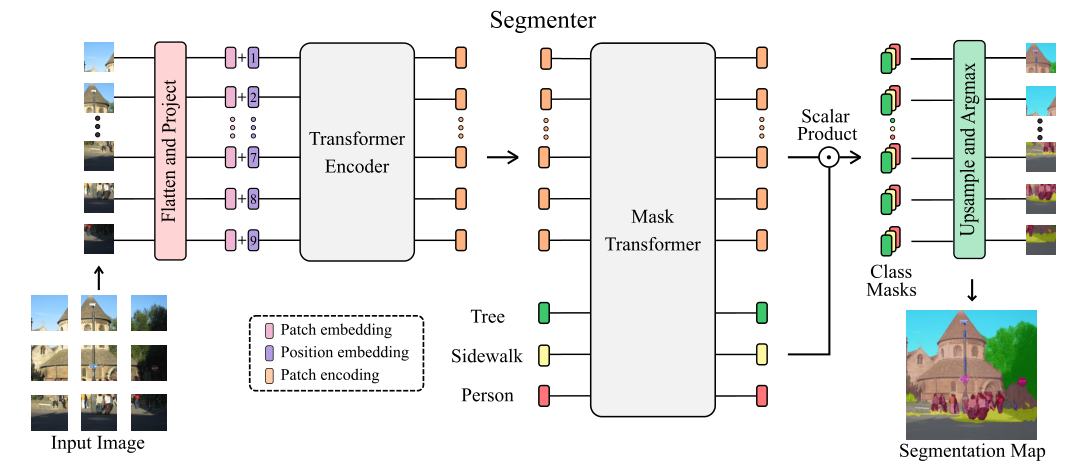
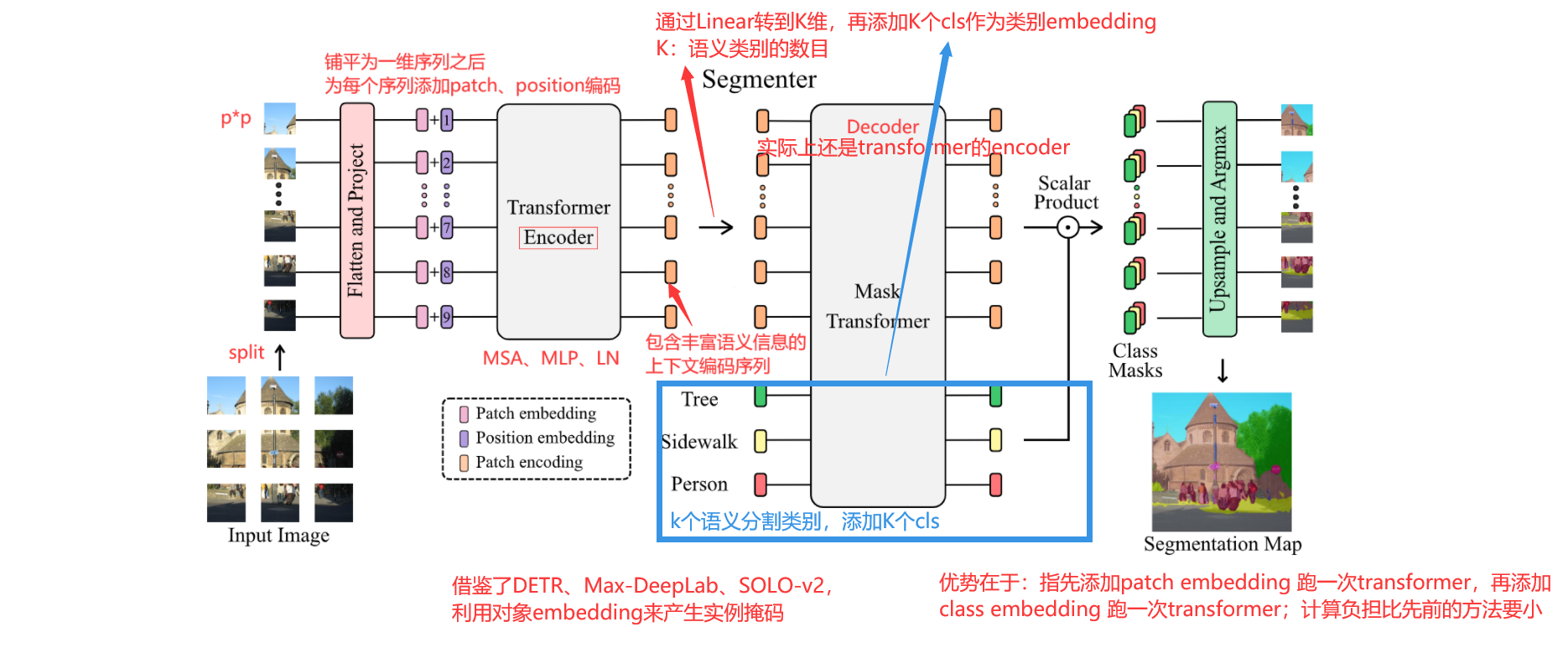
2.2 编码器
- 一个图像 x ∈ R H × W × C x\in R^{H\times W\times C} x∈RH×W×C被分割成一个块序列 x = [ x 1 , … , x N ] ∈ R N × P 2 × C \mathbf{x}=\left[x_{1}, \ldots, x_{N}\right] \in \mathbb{R}^{N \times P^{2} \times C} x=[x1,…,xN]∈RN×P2×C,其中 ( P , P ) (P,P) (P,P)是划分的块的大小, N = H W / P 2 N=H W / P^{2} N=HW/P2是块的数量,C是通道的数量。
- 每个块被压平成一个一维向量,然后线性投影到一个块嵌入,产生一个块嵌入序列 x 0 = [ E x 1 , … , E x N ] ∈ R N × D \mathbf{x}_{\mathbf{0}}=\left[\mathbf{E} x_{1}, \ldots, \mathbf{E} x_{N}\right] \in \mathbb{R}^{N \times D} x0=[Ex1,…,ExN]∈RN×D,其中 E ∈ R D × ( P 2 C ) \mathbf{E} \in \mathbb{R}^{D \times\left(P^{2} C\right)} E∈RD×(P2C)。
- 为了获取位置信息,将可学习的位置嵌入点 p o s = [ pos 1 , … , pos N ] ∈ R N × D \mathbf{p o s}=\left[\operatorname{pos}_{1}, \ldots,\operatorname{pos}_{N}\right] \in \mathbb{R}^{N \times D} pos=[pos1,…,posN]∈RN×D添加到块序列中,得到标记 z 0 = x 0 + p o s \mathbf{z}_{0}=\mathbf{x}_{0}+\mathbf{p o s} z0=x0+pos
- 将由L层组成的transformer编码器应用于标记 z 0 z_0 z0的序列,生成上下文化编码 Z L ∈ R N × D \mathbf{Z}_{L} \in \mathbb{R}^{N \times D} ZL∈RN×D序列。transformer层由一个多头自注意(MSA)块组成,然后是一个由两层组成的点向MLP块组成,在每个块之前应用LayerNorm(LN),在每个块之后添加残差块。
a i − 1 = MSA ( LN ( z i − 1 ) ) + z i − 1 z i = MLP ( LN ( a i − 1 ) ) + a i − 1
ai−1zi=MSA(LN(zi−1))+zi−1=MLP(LN(ai−1))+ai−1a i − 1 = MSA ( LN ( z i − 1 ) ) + z i − 1 z i = MLP ( LN ( a i − 1 ) ) + a i − 1 其中, i ∈ { 1 , ⋯ , L } i\in \{1,\cdots,L\} i∈{1,⋯,L}。
自注意机制由三个点向线性层映射标记到中间表示, Q ∈ R N × d , K ∈ R N × d , V ∈ R N × d \mathbf{Q} \in \mathbb{R}^{N \times d},\mathbf{K} \in \mathbb{R}^{N \times d},\mathbf{V} \in \mathbb{R}^{N \times d} Q∈RN×d,K∈RN×d,V∈RN×d组成。然后,自我注意的计算方法如下:
MSA ( Q , K , V ) = softmax ( Q K T d ) V \operatorname{MSA}(\mathbf{Q}, \mathbf{K}, \mathbf{V})=\operatorname{softmax}\left(\frac{\mathbf{Q} \mathbf{K}^{T}}{\sqrt{d}}\right) \mathbf{V} MSA(Q,K,V)=softmax(dQKT)V2.3 解码器
patch encodings Z L ∈ R N × D \mathbf{Z}_{\mathbf{L}} \in \mathbb{R}^{N \times D} ZL∈RN×D被解码为分割映射 s ∈ R H × W × K \mathbf{s} \in \mathbb{R}^{H \times W \times K} s∈RH×W×K,其中 K K K为类别数。
解码器学习将来自编码器的补丁级编码映射到补丁级的类分数。
接下来,这些 patch-level class scores 通过线性插值双线性插值上采样到 pixel-level scores 。我们将在下面描述一个线性解码器,它作为一个基线,而我们的方法是一个掩码转换器,见图2。
Linear
patch encodings( Z L ∈ R N × D \mathbf{Z}_{\mathbf{L}} \in \mathbb{R}^{N \times D} ZL∈RN×D)应用点向线性层,产生块级类对数 Z lin ∈ R N × K \mathbf{Z}_{\operatorname{lin}} \in \mathbb{R}^{N \times K} Zlin∈RN×K,然后将序列重塑为2D特征图 S lin ∈ R H / P × W / P × K \mathbf{S}_{\operatorname{lin}} \in \mathbb{R}^{H / P \times W / P \times K} Slin∈RH/P×W/P×K并提前上采样到原始图像大小 S ∈ R H × W × W \mathbf{S} \in \mathbb{R}^{H \times W \times W} S∈RH×W×W。然后在类维度上应用softmax,得到最终的分割映射。
Mask Transformer
对于基于transformer的解码器,我们引入了一组 K K K个可学习的类嵌入 [ c l s 1 , … , c l s K ] ∈ R K × D \left[\mathrm{cls}_{1}, \ldots, \mathrm{cls}_{K}\right] \in \mathbb{R} ^{K \times D} [cls1,…,clsK]∈RK×D,其中 K K K是类的数量。每个类的嵌入都被随机初始化,并分配给一个语义类。它将用于生成类掩码。类嵌入 c l s cls cls由解码器与补丁编码 z l z_l zl联合处理,如图2所示。
解码器是一个由M层组成的transformer编码器。我们的mask transformer 通过计算解码器输出的 L 2 L_2 L2标准化补丁嵌入 z M ′ ∈ R N × D \mathbf{z}_{\mathbf{M}}^{\prime} \in \mathbb{R}^{N \times D} zM′∈RN×D与类嵌入 c ∈ R K × D \mathbf{c} \in \mathbb{R}^{K \times D} c∈RK×D之间的标量乘积来生成K个掩码。类掩码的集合计算如下:
Masks ( z M ′ , c ) = z M ′ c T \operatorname{Masks}\left(\mathbf{z}_{\mathbf{M}}^{\prime}, \mathbf{c}\right)=\mathbf{z}_{\mathbf{M}}^{\prime} \mathbf{c}^{T} Masks(zM′,c)=zM′cT
其中, Masks ( z M ′ , c ) ∈ R N × K \operatorname{Masks}\left(\mathbf{z}_{\mathbf{M}}^{\prime}, \mathbf{c}\right) \in \mathbb{R}^{N \times K} Masks(zM′,c)∈RN×K是一组块序列。然后将每个mask序列重塑为二维mask,形成 S m a s k ∈ R H / P × W / P × K \mathbf{S}_{\mathbf{m a s k}} \in \mathbb{R}^{H / P \times W / P \times K} Smask∈RH/P×W/P×K,并提前上采样到原始图像大小,获得特征图 S ∈ R H × W × W \mathbf{S} \in \mathbb{R}^{H \times W \times W} S∈RH×W×W。然后在类维度上应用一个softmax,然后应用一个层范数,得到像素级的类分数,形成最终的分割图。
我们的Mask Transformer受到了DETR[7]、MaxDeepLab[52]和SOLO-v2[55]的启发,它们引入了对象嵌入[7]来生成实例掩码[52,55]。然而,与我们的方法不同的是,MaxDeep-Lab使用了一种基于cnn和transformer的混合方法,并由于计算限制,将像素和类嵌入分割成两个流。使用纯Transformer架构和利用块编码,我们提出了一种简单的方法,在解码阶段联合处理块和类嵌入。这种方法允许产生动态滤波器,随输入而变化。当我们在这项工作中处理语义分割时,我们的Mask Transformer也可以直接适应于通过用对象嵌入替换类嵌入来执行实例分割。
2.4 结果
他们发现随机深度(Stochastic Depth)方案可独立提高性能,而dropout无论是单独还是与随机深度相结合,都会损耗性能。
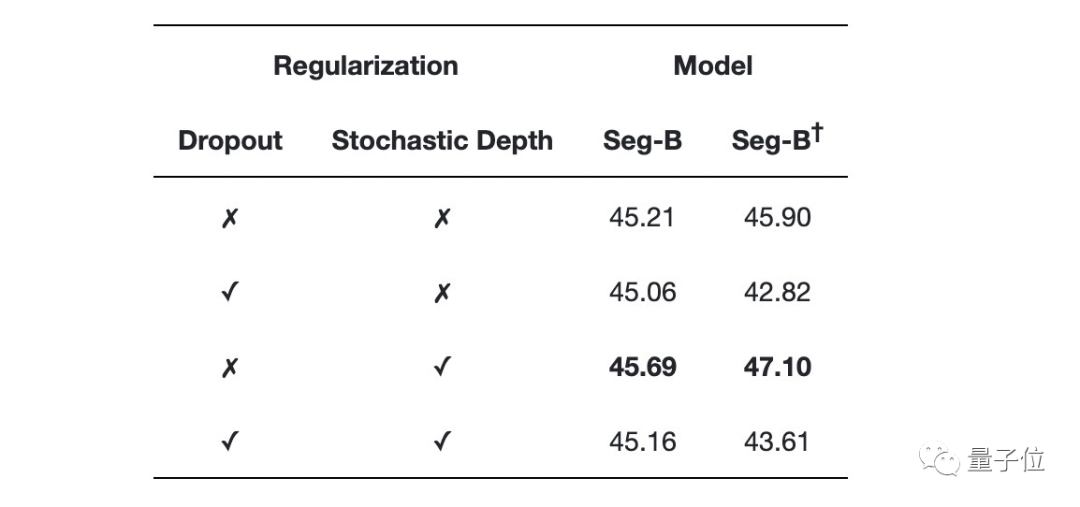
不同图像块大小和不同transformer的性能比较发现:
增加图像块的大小会导致图像的表示更粗糙,但会产生处理速度更快的小序列。
减少图像块大小是一个强大的改进方式,不用引入任何参数!但需要在较长的序列上计算Attention,会增加计算时间和内存占用。
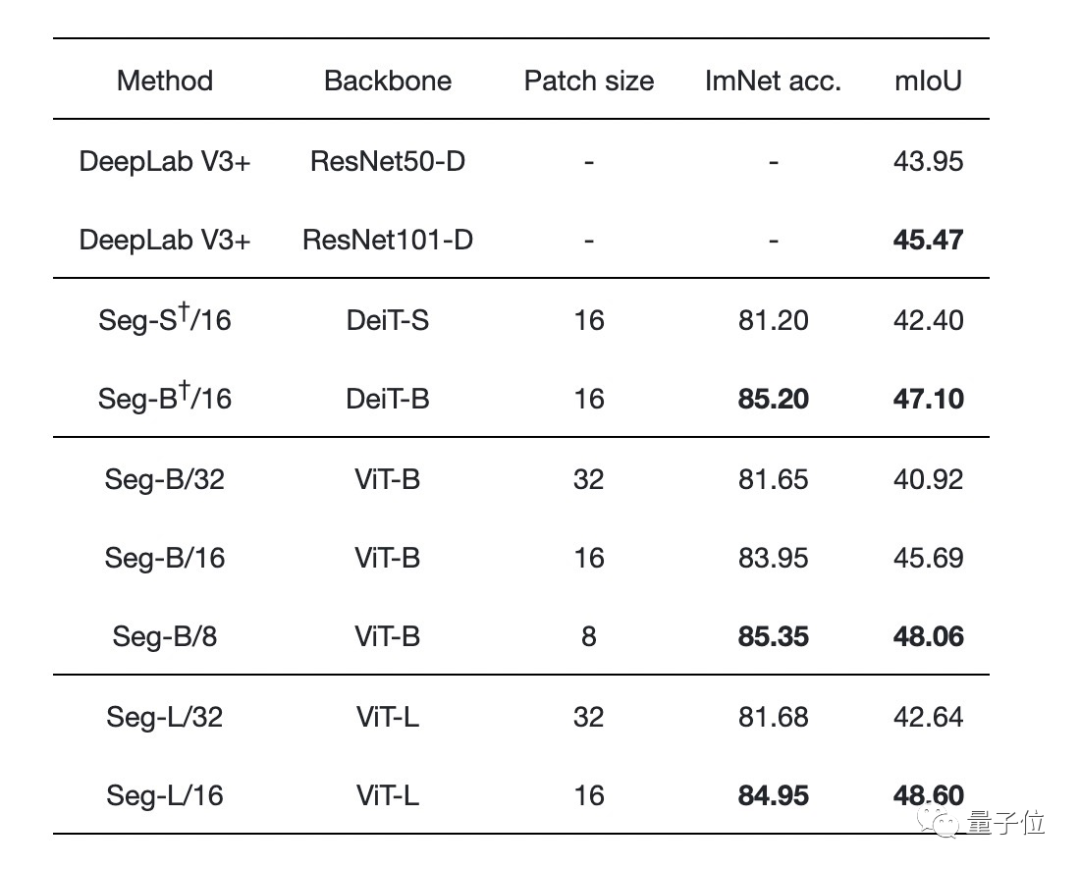
Segmenter在使用大型transformer模型或小规模图像块的情况下更优:
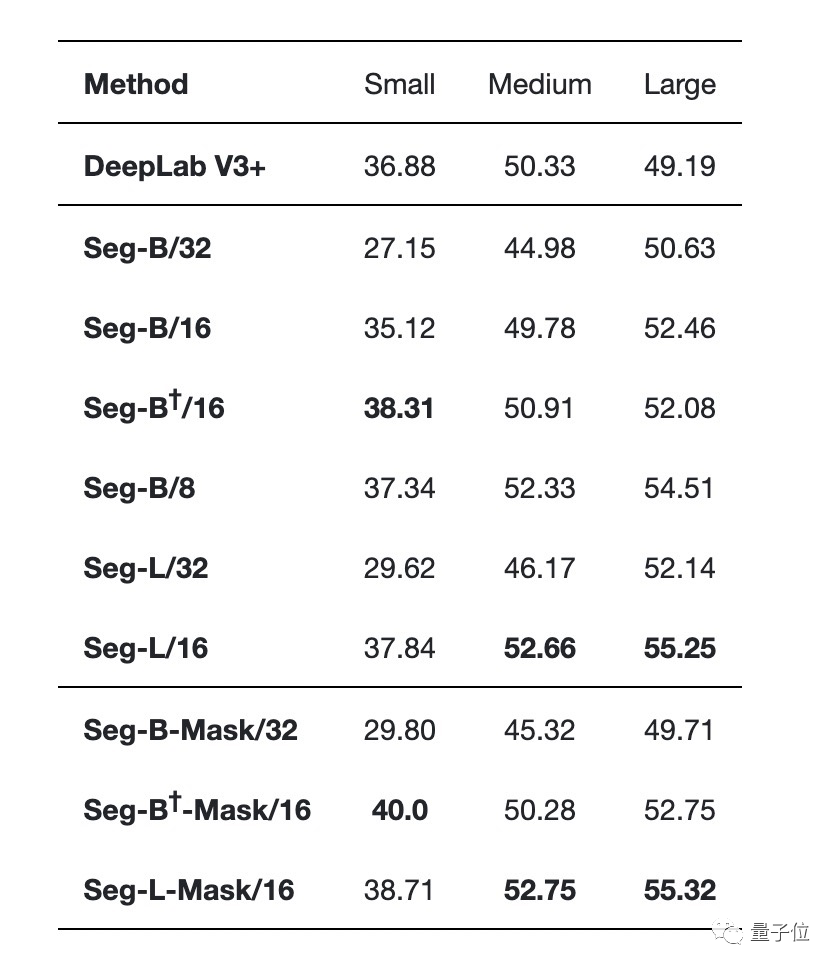
(表中间是带有线性解码器的不同编码器,表底部是带有Mask Transformer作为解码器的不同编码器)
下图也显示了Segmenter的明显优势,其中Seg/16模型(图像块大小为16x16)在性能与准确性方面表现最好。
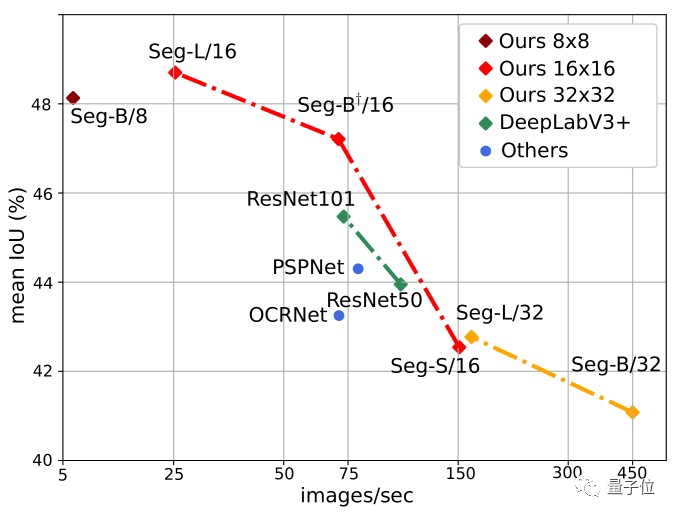
最后,我们再来看看Segmenter与SOTA的比较:
在最具挑战性的ADE20K数据集上,Segmenter两项指标均高于所有SOTA模型!

(中间太长已省略)
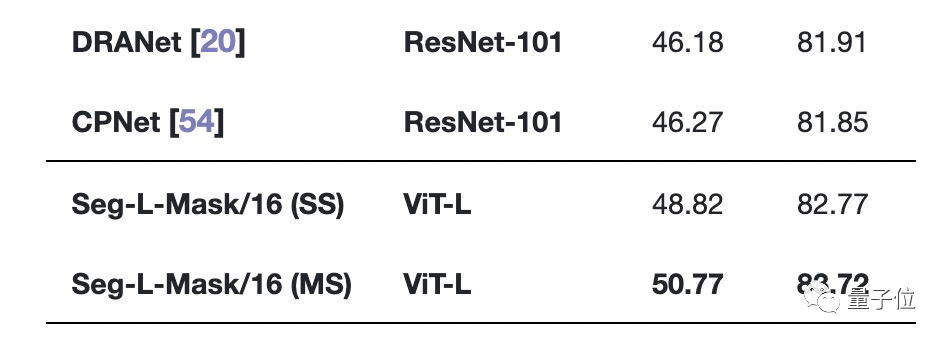
在Cityscapes数据集上与大多数SOTA不相上下,只比性能最好的Panoptic-Deeplab低0.8。

在Pascal Context数据集上的表现也是如此。

剩余参数比较,大家有兴趣的可按需查看论文细节。
ADE20K
Method Backbone Crop Size Lr schd Mem (GB) Inf time (fps) mIoU mIoU(ms+flip) Segmenter Mask ViT-T_16 512x512 160000 1.21 27.98 39.99 40.83 Segmenter Linear ViT-S_16 512x512 160000 1.78 28.07 45.75 46.82 Segmenter Mask ViT-S_16 512x512 160000 2.03 24.80 46.19 47.85 Segmenter Mask ViT-B_16 512x512 160000 4.20 13.20 49.60 51.07 Segmenter Mask ViT-L_16 640x640 160000 16.99 3.03 51.65 53.58 3. 代码
import math import torch import torch.nn as nn from einops import rearrange from pathlib import Path import torch.nn.functional as F from timm.models.layers import DropPath, trunc_normal_, to_2tuple from timm.models.vision_transformer import _load_weights def padding(im, patch_size, fill_value=0): # make the image sizes divisible by patch_size H, W = im.size(2), im.size(3) pad_h, pad_w = 0, 0 if H % patch_size > 0: pad_h = patch_size - (H % patch_size) if W % patch_size > 0: pad_w = patch_size - (W % patch_size) im_padded = im if pad_h > 0 or pad_w > 0: im_padded = F.pad(im, (0, pad_w, 0, pad_h), value=fill_value) return im_padded def unpadding(y, target_size): H, W = target_size H_pad, W_pad = y.size(2), y.size(3) # crop predictions on extra pixels coming from padding extra_h = H_pad - H extra_w = W_pad - W if extra_h > 0: y = y[:, :, :-extra_h] if extra_w > 0: y = y[:, :, :, :-extra_w] return y def init_weights(m): """ 初始化参数 Args: m: Returns: """ if isinstance(m, nn.Linear): trunc_normal_(m.weight, std=0.02) if isinstance(m, nn.Linear) and m.bias is not None: nn.init.constant_(m.bias, 0) elif isinstance(m, nn.LayerNorm): nn.init.constant_(m.bias, 0) nn.init.constant_(m.weight, 1.0) def resize_pos_embed(posemb, grid_old_shape, grid_new_shape, num_extra_tokens): # Rescale the grid of position embeddings when loading from state_dict. Adapted from # https://github.com/google-research/vision_transformer/blob/00883dd691c63a6830751563748663526e811cee/vit_jax/checkpoint.py#L224 posemb_tok, posemb_grid = ( posemb[:, :num_extra_tokens], posemb[0, num_extra_tokens:], ) if grid_old_shape is None: gs_old_h = int(math.sqrt(len(posemb_grid))) gs_old_w = gs_old_h else: gs_old_h, gs_old_w = grid_old_shape gs_h, gs_w = grid_new_shape posemb_grid = posemb_grid.reshape(1, gs_old_h, gs_old_w, -1).permute(0, 3, 1, 2) posemb_grid = F.interpolate(posemb_grid, size=(gs_h, gs_w), mode="bilinear") posemb_grid = posemb_grid.permute(0, 2, 3, 1).reshape(1, gs_h * gs_w, -1) posemb = torch.cat([posemb_tok, posemb_grid], dim=1) return posemb ############################### ################### # 编码器 class FeedForward(nn.Module): def __init__(self, dim, hidden_dim, dropout, out_dim=None): super().__init__() self.fc1 = nn.Linear(dim, hidden_dim) self.act = nn.GELU() if out_dim is None: out_dim = dim self.fc2 = nn.Linear(hidden_dim, out_dim) self.drop = nn.Dropout(dropout) @property def unwrapped(self): return self def forward(self, x): x = self.fc1(x) x = self.act(x) x = self.drop(x) x = self.fc2(x) x = self.drop(x) return x class Attention(nn.Module): def __init__(self, dim, heads, dropout): super().__init__() self.heads = heads head_dim = dim // heads self.scale = head_dim ** -0.5 self.attn = None self.qkv = nn.Linear(dim, dim * 3) self.attn_drop = nn.Dropout(dropout) self.proj = nn.Linear(dim, dim) self.proj_drop = nn.Dropout(dropout) @property def unwrapped(self): return self def forward(self, x, mask=None): B, N, C = x.shape qkv = ( self.qkv(x) .reshape(B, N, 3, self.heads, C // self.heads) .permute(2, 0, 3, 1, 4) ) q, k, v = ( qkv[0], qkv[1], qkv[2], ) attn = (q @ k.transpose(-2, -1)) * self.scale attn = attn.softmax(dim=-1) attn = self.attn_drop(attn) x = (attn @ v).transpose(1, 2).reshape(B, N, C) x = self.proj(x) x = self.proj_drop(x) return x, attn class Block(nn.Module): def __init__(self, dim, heads, mlp_dim, dropout, drop_path): """ transformer block 结构 Args: dim: heads: mlp_dim: dropout: drop_path: """ super().__init__() self.norm1 = nn.LayerNorm(dim) self.norm2 = nn.LayerNorm(dim) self.attn = Attention(dim, heads, dropout) self.mlp = FeedForward(dim, mlp_dim, dropout) self.drop_path = DropPath(drop_path) if drop_path > 0.0 else nn.Identity() def forward(self, x, mask=None, return_attention=False): y, attn = self.attn(self.norm1(x), mask) if return_attention: return attn x = x + self.drop_path(y) x = x + self.drop_path(self.mlp(self.norm2(x))) return x class PatchEmbedding(nn.Module): def __init__(self, image_size, patch_size, embed_dim, channels): super().__init__() self.image_size = image_size if image_size[0] % patch_size != 0 or image_size[1] % patch_size != 0: raise ValueError("image dimensions must be divisible by the patch size") self.grid_size = image_size[0] // patch_size, image_size[1] // patch_size self.num_patches = self.grid_size[0] * self.grid_size[1] self.patch_size = patch_size self.proj = nn.Conv2d( channels, embed_dim, kernel_size=patch_size, stride=patch_size ) def forward(self, im): B, C, H, W = im.shape x = self.proj(im).flatten(2).transpose(1, 2) return x class VisionTransformer(nn.Module): def __init__( self, image_size, patch_size, n_layers, d_model, d_ff, n_heads, n_cls, dropout=0.1, drop_path_rate=0.0, distilled=False, channels=3, ): super().__init__() self.patch_embed = PatchEmbedding( image_size, patch_size, d_model, channels, ) self.patch_size = patch_size self.n_layers = n_layers self.d_model = d_model self.d_ff = d_ff self.n_heads = n_heads self.dropout = nn.Dropout(dropout) self.n_cls = n_cls # cls and pos tokens self.cls_token = nn.Parameter(torch.zeros(1, 1, d_model)) self.distilled = distilled if self.distilled: self.dist_token = nn.Parameter(torch.zeros(1, 1, d_model)) self.pos_embed = nn.Parameter( torch.randn(1, self.patch_embed.num_patches + 2, d_model) ) self.head_dist = nn.Linear(d_model, n_cls) else: self.pos_embed = nn.Parameter( torch.randn(1, self.patch_embed.num_patches + 1, d_model) ) # transformer blocks dpr = [x.item() for x in torch.linspace(0, drop_path_rate, n_layers)] self.blocks = nn.ModuleList( [Block(d_model, n_heads, d_ff, dropout, dpr[i]) for i in range(n_layers)] ) # output head self.norm = nn.LayerNorm(d_model) self.head = nn.Linear(d_model, n_cls) trunc_normal_(self.pos_embed, std=0.02) trunc_normal_(self.cls_token, std=0.02) if self.distilled: trunc_normal_(self.dist_token, std=0.02) self.pre_logits = nn.Identity() self.apply(init_weights) @torch.jit.ignore def no_weight_decay(self): return {"pos_embed", "cls_token", "dist_token"} @torch.jit.ignore() def load_pretrained(self, checkpoint_path, prefix=""): _load_weights(self, checkpoint_path, prefix) def forward(self, im, return_features=False): B, _, H, W = im.shape PS = self.patch_size x = self.patch_embed(im) cls_tokens = self.cls_token.expand(B, -1, -1) if self.distilled: dist_tokens = self.dist_token.expand(B, -1, -1) x = torch.cat((cls_tokens, dist_tokens, x), dim=1) else: x = torch.cat((cls_tokens, x), dim=1) pos_embed = self.pos_embed num_extra_tokens = 1 + self.distilled if x.shape[1] != pos_embed.shape[1]: pos_embed = resize_pos_embed( pos_embed, self.patch_embed.grid_size, (H // PS, W // PS), num_extra_tokens, ) x = x + pos_embed x = self.dropout(x) for blk in self.blocks: x = blk(x) x = self.norm(x) if return_features: return x if self.distilled: x, x_dist = x[:, 0], x[:, 1] x = self.head(x) x_dist = self.head_dist(x_dist) x = (x + x_dist) / 2 else: x = x[:, 0] x = self.head(x) return x def get_attention_map(self, im, layer_id): if layer_id >= self.n_layers or layer_id < 0: raise ValueError( f"Provided layer_id: {layer_id} is not valid. 0 <= {layer_id} < {self.n_layers}." ) B, _, H, W = im.shape PS = self.patch_size x = self.patch_embed(im) cls_tokens = self.cls_token.expand(B, -1, -1) if self.distilled: dist_tokens = self.dist_token.expand(B, -1, -1) x = torch.cat((cls_tokens, dist_tokens, x), dim=1) else: x = torch.cat((cls_tokens, x), dim=1) pos_embed = self.pos_embed num_extra_tokens = 1 + self.distilled if x.shape[1] != pos_embed.shape[1]: pos_embed = resize_pos_embed( pos_embed, self.patch_embed.grid_size, (H // PS, W // PS), num_extra_tokens, ) x = x + pos_embed for i, blk in enumerate(self.blocks): if i < layer_id: x = blk(x) else: return blk(x, return_attention=True) ####################################################################### # 解码器 class DecoderLinear(nn.Module): def __init__(self, n_cls, patch_size, d_encoder): super().__init__() self.d_encoder = d_encoder self.patch_size = patch_size self.n_cls = n_cls self.head = nn.Linear(self.d_encoder, n_cls) self.apply(init_weights) @torch.jit.ignore def no_weight_decay(self): return set() def forward(self, x, im_size): H, W = im_size GS = H // self.patch_size x = self.head(x) x = rearrange(x, "b (h w) c -> b c h w", h=GS) return x class MaskTransformer(nn.Module): """ 解码器部分 """ def __init__( self, n_cls, patch_size, d_encoder, n_layers, n_heads, d_model, d_ff, drop_path_rate, dropout, ): super().__init__() self.d_encoder = d_encoder self.patch_size = patch_size self.n_layers = n_layers self.n_cls = n_cls self.d_model = d_model self.d_ff = d_ff self.scale = d_model ** -0.5 dpr = [x.item() for x in torch.linspace(0, drop_path_rate, n_layers)] self.blocks = nn.ModuleList( [Block(d_model, n_heads, d_ff, dropout, dpr[i]) for i in range(n_layers)] ) self.cls_emb = nn.Parameter(torch.randn(1, n_cls, d_model)) self.proj_dec = nn.Linear(d_encoder, d_model) self.proj_patch = nn.Parameter(self.scale * torch.randn(d_model, d_model)) self.proj_classes = nn.Parameter(self.scale * torch.randn(d_model, d_model)) self.decoder_norm = nn.LayerNorm(d_model) self.mask_norm = nn.LayerNorm(n_cls) self.apply(init_weights) trunc_normal_(self.cls_emb, std=0.02) @torch.jit.ignore def no_weight_decay(self): return {"cls_emb"} def forward(self, x, im_size): H, W = im_size GS = H // self.patch_size x = self.proj_dec(x) cls_emb = self.cls_emb.expand(x.size(0), -1, -1) x = torch.cat((x, cls_emb), 1) for blk in self.blocks: x = blk(x) x = self.decoder_norm(x) patches, cls_seg_feat = x[:, : -self.n_cls], x[:, -self.n_cls:] patches = patches @ self.proj_patch cls_seg_feat = cls_seg_feat @ self.proj_classes patches = patches / patches.norm(dim=-1, keepdim=True) cls_seg_feat = cls_seg_feat / cls_seg_feat.norm(dim=-1, keepdim=True) masks = patches @ cls_seg_feat.transpose(1, 2) masks = self.mask_norm(masks) masks = rearrange(masks, "b (h w) n -> b n h w", h=int(GS)) return masks def get_attention_map(self, x, layer_id): if layer_id >= self.n_layers or layer_id < 0: raise ValueError( f"Provided layer_id: {layer_id} is not valid. 0 <= {layer_id} < {self.n_layers}." ) x = self.proj_dec(x) cls_emb = self.cls_emb.expand(x.size(0), -1, -1) x = torch.cat((x, cls_emb), 1) for i, blk in enumerate(self.blocks): if i < layer_id: x = blk(x) else: return blk(x, return_attention=True) class Segmenter(nn.Module): """ segmenter 模型代码 """ def __init__( self, encoder, decoder, n_cls, ): super().__init__() self.n_cls = n_cls self.patch_size = encoder.patch_size self.encoder = encoder self.decoder = decoder @torch.jit.ignore def no_weight_decay(self): def append_prefix_no_weight_decay(prefix, module): return set(map(lambda x: prefix + x, module.no_weight_decay())) nwd_params = append_prefix_no_weight_decay("encoder.", self.encoder).union( append_prefix_no_weight_decay("decoder.", self.decoder) ) return nwd_params def forward(self, im): H_ori, W_ori = im.size(2), im.size(3) im = padding(im, self.patch_size) H, W = im.size(2), im.size(3) x = self.encoder(im, return_features=True) # remove CLS/DIST tokens for decoding num_extra_tokens = 1 + self.encoder.distilled x = x[:, num_extra_tokens:] masks = self.decoder(x, (H, W)) masks = F.interpolate(masks, size=(H, W), mode="bilinear") masks = unpadding(masks, (H_ori, W_ori)) return masks def get_attention_map_enc(self, im, layer_id): return self.encoder.get_attention_map(im, layer_id) def get_attention_map_dec(self, im, layer_id): x = self.encoder(im, return_features=True) # remove CLS/DIST tokens for decoding num_extra_tokens = 1 + self.encoder.distilled x = x[:, num_extra_tokens:] return self.decoder.get_attention_map(x, layer_id) cfg = { "vit_base_patch8_384": { "image_size": 384, "patch_size": 8, "d_model": 768, "n_heads": 12, "n_layers": 12, "normalization": "vit", "distilled": False }, "vit_tiny_patch16_384": { "image_size": 384, "patch_size": 16, "d_model": 192, "n_heads": 3, "n_layers": 12, "normalization": "vit", "distilled": False }, "vit_base_patch16_384": { "image_size": 384, "patch_size": 16, "d_model": 768, "n_heads": 12, "n_layers": 12, "normalization": "vit", "distilled": False }, "vit_large_patch16_384": { "image_size": 384, "patch_size": 16, "d_model": 1024, "n_heads": 16, "n_layers": 24, "normalization": "vit", "distilled": False }, "vit_small_patch32_384": { "image_size": 384, "patch_size": 32, "d_model": 384, "n_heads": 6, "n_layers": 12, "normalization": "vit", "distilled": False }, "vit_base_patch32_384": { "image_size": 384, "patch_size": 32, "d_model": 768, "n_heads": 12, "n_layers": 12, "normalization": "vit", "distilled": False }, "vit_large_patch32_384": { "image_size": 384, "patch_size": 32, "d_model": 1024, "n_heads": 16, "n_layers": 24, "normalization": "vit", "distilled": False } } def create_model(num_classes=10, image_size=224, backbone="vit_base_patch8_384"): model_cfg = cfg[backbone] image_size = image_size patch_size = model_cfg["patch_size"] n_layers = model_cfg["n_layers"] d_model = model_cfg["d_model"] n_heads = model_cfg["n_heads"] mlp_expansion_ratio = 4 d_ff = mlp_expansion_ratio * model_cfg["d_model"] if type(image_size) is not tuple: image_size = to_2tuple(image_size) encoder = VisionTransformer( image_size=image_size, patch_size=patch_size, n_layers=n_layers, d_model=d_model, n_heads=n_heads, d_ff=d_ff, n_cls=num_classes, ) dim = d_model n_heads = dim // 64 decoder = MaskTransformer( n_cls=num_classes, patch_size=patch_size, d_encoder=d_model, n_layers=2, n_heads=n_heads, d_model=d_model, d_ff=4 * dim, drop_path_rate=0.0, dropout=0.1, ) model = Segmenter(encoder, decoder, n_cls=num_classes) return model def vit_base_patch8_384(pretrained=False, **kwargs): return create_model(backbone="vit_base_patch8_384", **kwargs) def vit_tiny_patch16_384(pretrained=False, **kwargs): return create_model(backbone="vit_tiny_patch16_384", **kwargs) def vit_base_patch16_384(pretrained=False, **kwargs): return create_model(backbone="vit_base_patch16_384", **kwargs) def vit_large_patch16_384(pretrained=False, **kwargs): return create_model(backbone="vit_large_patch16_384", **kwargs) def vit_small_patch32_384(pretrained=False, **kwargs): return create_model(backbone="vit_small_patch32_384", **kwargs) def vit_base_patch32_384(pretrained=False, **kwargs): return create_model(backbone="vit_base_patch32_384", **kwargs) def vit_large_patch32_384(pretrained=False, **kwargs): return create_model(backbone="vit_large_patch32_384", **kwargs) if __name__ == '__main__': x = torch.randn(2, 3, 224,224) model = vit_small_patch32_384(num_classes=19) y = model(x) print(y.shape)- 1
- 2
- 3
- 4
- 5
- 6
- 7
- 8
- 9
- 10
- 11
- 12
- 13
- 14
- 15
- 16
- 17
- 18
- 19
- 20
- 21
- 22
- 23
- 24
- 25
- 26
- 27
- 28
- 29
- 30
- 31
- 32
- 33
- 34
- 35
- 36
- 37
- 38
- 39
- 40
- 41
- 42
- 43
- 44
- 45
- 46
- 47
- 48
- 49
- 50
- 51
- 52
- 53
- 54
- 55
- 56
- 57
- 58
- 59
- 60
- 61
- 62
- 63
- 64
- 65
- 66
- 67
- 68
- 69
- 70
- 71
- 72
- 73
- 74
- 75
- 76
- 77
- 78
- 79
- 80
- 81
- 82
- 83
- 84
- 85
- 86
- 87
- 88
- 89
- 90
- 91
- 92
- 93
- 94
- 95
- 96
- 97
- 98
- 99
- 100
- 101
- 102
- 103
- 104
- 105
- 106
- 107
- 108
- 109
- 110
- 111
- 112
- 113
- 114
- 115
- 116
- 117
- 118
- 119
- 120
- 121
- 122
- 123
- 124
- 125
- 126
- 127
- 128
- 129
- 130
- 131
- 132
- 133
- 134
- 135
- 136
- 137
- 138
- 139
- 140
- 141
- 142
- 143
- 144
- 145
- 146
- 147
- 148
- 149
- 150
- 151
- 152
- 153
- 154
- 155
- 156
- 157
- 158
- 159
- 160
- 161
- 162
- 163
- 164
- 165
- 166
- 167
- 168
- 169
- 170
- 171
- 172
- 173
- 174
- 175
- 176
- 177
- 178
- 179
- 180
- 181
- 182
- 183
- 184
- 185
- 186
- 187
- 188
- 189
- 190
- 191
- 192
- 193
- 194
- 195
- 196
- 197
- 198
- 199
- 200
- 201
- 202
- 203
- 204
- 205
- 206
- 207
- 208
- 209
- 210
- 211
- 212
- 213
- 214
- 215
- 216
- 217
- 218
- 219
- 220
- 221
- 222
- 223
- 224
- 225
- 226
- 227
- 228
- 229
- 230
- 231
- 232
- 233
- 234
- 235
- 236
- 237
- 238
- 239
- 240
- 241
- 242
- 243
- 244
- 245
- 246
- 247
- 248
- 249
- 250
- 251
- 252
- 253
- 254
- 255
- 256
- 257
- 258
- 259
- 260
- 261
- 262
- 263
- 264
- 265
- 266
- 267
- 268
- 269
- 270
- 271
- 272
- 273
- 274
- 275
- 276
- 277
- 278
- 279
- 280
- 281
- 282
- 283
- 284
- 285
- 286
- 287
- 288
- 289
- 290
- 291
- 292
- 293
- 294
- 295
- 296
- 297
- 298
- 299
- 300
- 301
- 302
- 303
- 304
- 305
- 306
- 307
- 308
- 309
- 310
- 311
- 312
- 313
- 314
- 315
- 316
- 317
- 318
- 319
- 320
- 321
- 322
- 323
- 324
- 325
- 326
- 327
- 328
- 329
- 330
- 331
- 332
- 333
- 334
- 335
- 336
- 337
- 338
- 339
- 340
- 341
- 342
- 343
- 344
- 345
- 346
- 347
- 348
- 349
- 350
- 351
- 352
- 353
- 354
- 355
- 356
- 357
- 358
- 359
- 360
- 361
- 362
- 363
- 364
- 365
- 366
- 367
- 368
- 369
- 370
- 371
- 372
- 373
- 374
- 375
- 376
- 377
- 378
- 379
- 380
- 381
- 382
- 383
- 384
- 385
- 386
- 387
- 388
- 389
- 390
- 391
- 392
- 393
- 394
- 395
- 396
- 397
- 398
- 399
- 400
- 401
- 402
- 403
- 404
- 405
- 406
- 407
- 408
- 409
- 410
- 411
- 412
- 413
- 414
- 415
- 416
- 417
- 418
- 419
- 420
- 421
- 422
- 423
- 424
- 425
- 426
- 427
- 428
- 429
- 430
- 431
- 432
- 433
- 434
- 435
- 436
- 437
- 438
- 439
- 440
- 441
- 442
- 443
- 444
- 445
- 446
- 447
- 448
- 449
- 450
- 451
- 452
- 453
- 454
- 455
- 456
- 457
- 458
- 459
- 460
- 461
- 462
- 463
- 464
- 465
- 466
- 467
- 468
- 469
- 470
- 471
- 472
- 473
- 474
- 475
- 476
- 477
- 478
- 479
- 480
- 481
- 482
- 483
- 484
- 485
- 486
- 487
- 488
- 489
- 490
- 491
- 492
- 493
- 494
- 495
- 496
- 497
- 498
- 499
- 500
- 501
- 502
- 503
- 504
- 505
- 506
- 507
- 508
- 509
- 510
- 511
- 512
- 513
- 514
- 515
- 516
- 517
- 518
- 519
- 520
- 521
- 522
- 523
- 524
- 525
- 526
- 527
- 528
- 529
- 530
- 531
- 532
- 533
- 534
- 535
- 536
- 537
- 538
- 539
- 540
- 541
- 542
- 543
- 544
- 545
- 546
- 547
- 548
- 549
- 550
- 551
- 552
- 553
- 554
- 555
- 556
- 557
- 558
- 559
- 560
- 561
- 562
- 563
- 564
- 565
- 566
- 567
- 568
- 569
- 570
- 571
- 572
- 573
- 574
- 575
- 576
- 577
- 578
- 579
- 580
- 581
- 582
- 583
- 584
- 585
- 586
- 587
- 588
- 589
- 590
- 591
- 592
- 593
- 594
- 595
- 596
- 597
- 598
- 599
- 600
- 601
- 602
- 603
- 604
- 605
- 606
- 607
- 608
- 609
- 610
- 611
- 612
- 613
- 614
- 615
- 616
- 617
- 618
- 619
- 620
- 621
- 622
- 623
- 624
- 625
- 626
- 627
- 628
- 629
- 630
- 631
- 632
- 633
- 634
- 635
- 636
- 637
- 638
- 639
- 640
- 641
- 642
- 643
- 644
- 645
- 646
- 647
- 648
- 649
- 650
- 651
- 652
- 653
- 654
- 655
参考资料
-
相关阅读:
3.4、Linux小程序:进度条
Causality
C#中的DateTime类
基于SpringCloudalibaba+SSM+Mybatisplus实现在线教育讲师管理后端
MySQL 日志管理
基于物联网表计的综合能源管理方案-安科瑞黄安南
工业互联网系列白皮书(合集)
2022年最新四川交安安全员考试题库及答案
Qt加载SVG矢量图片,放大缩小图片质量不发生变化。
3.8背景总结
- 原文地址:https://blog.csdn.net/wujing1_1/article/details/126286742
